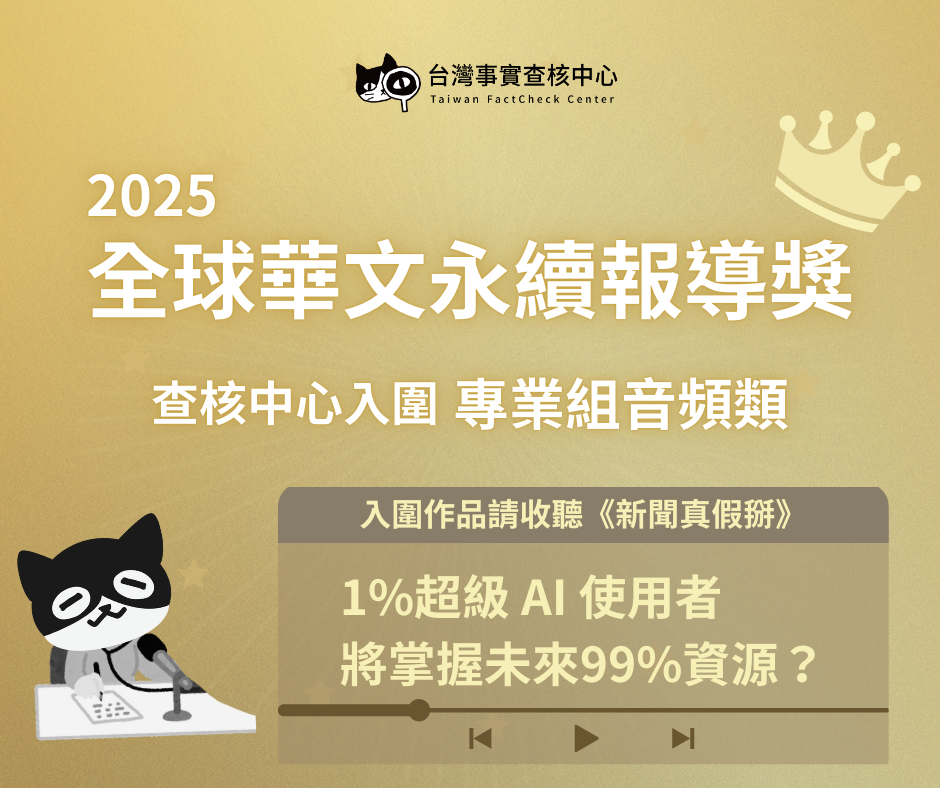AI: a double-edged sword for fact-checking
AI: a double-edged sword for fact-checking
The age of AI has begun; will artificial intelligence be a boon for fact-checking or a bane that makes disinformation ever more difficult to detect? The answer might be both.
Facing new AI-generated tools such as ChatGPT and image generators, fact-checkers from Argentina, Brazil, and Spain, at the Forum on Fact-Checking in Asia 2023, told the audience that while AI automated tools accelerate fact-checking, AI-generated fake news has also posed great challenges to fact-checkers.
The panel on AI’s effect on fact-checking took place on the Forum's second day, moderated by Ming-Hung Wang, assistant professor of computer science and information engineering at National Chung Cheng University. The panelists were Chequeado executive director Pablo M. Fernandez from Argentina, Aos Fatos executive director Tai Nalon from Brazil, and Carlos Echevarria, head of public policy of Maldita.es from Spain.
Image: (from left) Ming-Hung Wang, assistant professor of computer science and information engineering at National Chung Cheng University, Chequeado executive director Pablo M. Fernandez from Argentina, Aos Fatos executive director Tai Nalon from Brazil, and Carlos Echevarria, head of public policy of Maldita.es from Spain. (Photo/ Yuan-Bin Zhao)
Speeding Up Fact-checking
Chequeado, established in 2010, was the first fact-checking organization in Latin America. Fernandez said that as disinformation spreads much faster than fact-checking, it is imperative to accelerate the latter, which is a time- and energy-consuming task.
The group started to develop AI tools in 2017 to automate repetitive tasks, which helped save time for more intricate work. Chequeabot is one of such tool developed by the group that uses AI and Natural Language Processing (NLP) to scan and check claims on media outlets.
Fernandez said AI machines are assisting fact-checkers to find what is to be fact-checked from the national news and public online discussion. Via machine learning, they can also make preliminary judgments about the importance of the content - whether it is worth fact-checking.
AI is to assist journalists, not to take their place, Fernandez said, stressing that many elements in the fact-checking process still rely on human judgment.
Image: Chequeado executive director Pablo M. Fernandez from Argentina. (Photo/ Yuan-Bin Zhao)
Monitoring Social Media
Tai Nalon, executive director of Brazil’s fact-checking organization Aos Fatos, shared the experience of the group’s project, RADAR, which uses algorithms to monitor WhatsApp, Twitter, Facebook, Instagram, and YouTube and find the flow of disinformation.
The platform analyzes over 500,000 feeds every week, she said. During emergencies such as the pandemic, the Brazilian presidential election period, and the Brazil Congress attack this January, RADAR could locate and record the spread of disinformation.
Golpeflix, for instance, is a catalog of images and videos about the congress attack that the Aos Fatos team compiled using RADAR to collect more than 140,000 feeds on social media platforms. The record shows how incorrect information on the internet converged and turned into violence in the real world.
Image: Aos Fatos executive director Tai Nalon presented the catalog Golpeflix, an image archive of the Brazil congress attack incident. (Photo/ Yuan-Bin Zhao)
Early Warnings
Maldita.es uses automated monitoring tools and chatbots to monitor social media communities, collecting and identifying mis- and disinformation, said Echevarria.
The AI-enabled Whatsapp chatbot developed by Maldita.es found that the number of rumors increased from 200 to 2,000 a day during the pandemic between January and March 2020. The automated chatbot was crucial during the pandemic as it could tell the users where the fact-checks were and alert fact-checkers.
Language is the primary vehicle of disinformation, but videos can overcome the language barrier, he pointed out, adding that in the past year, more than 85 percent of the disinformation about the Ukraine-Russia War had been spread in the format of videos.
The AI chatbot could help debunk language-based content but also video content, which would be checked for signs of editing.
Maldita.es has also been working on a monitoring tool that integrates ChatGPT to debunk rumors. The tool is able to send out “warnings” to fact-checkers, informing them of emerging misinformative content that could effectively decrease personal bias in choosing what is to fact-check.
Image: “Putting humans where they matter the most,” Carlos Echevarria, head of public policy of Maldita.es said. (Photo/ Yuan-Bin Zhao)
Using AI to fight AI-generated Disinformation
Wang said while many media and fact-checking organizations have been striving to use AI tools for their work, the key, however, is not to expect AI to solve everything or focus solely on “using AI.”
The priority is to analyze the organization’s daily work, find the core problems, and then use AI effectively to solve them.
Fernandez seconded Wang’s point, saying that tools should be customized according to the newsroom’s needs. He emphasized that to develop such tools, one can rely on free, open-source options and collaborate with academic institutions or professional developers.
You can read the Chinese version of this article here.



